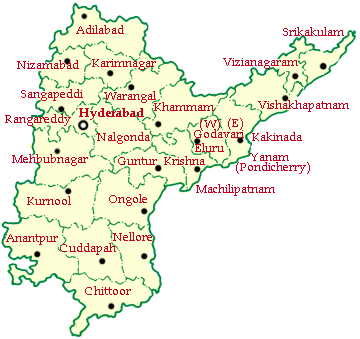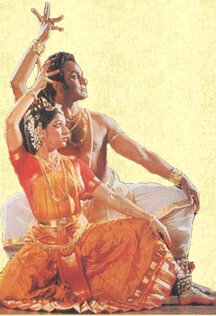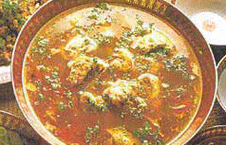|

Welcome
|
|
|
|
|
|
|
|
|
|
|
|
|
|
|
|
|
|
|
|
|
|
|
|
|
|
|
|
|
|
|
|
|
|
|
|
|
|
|
|
|
|
|
|
|
|
|
|
|
|
|
|
|
|
|
|
|
|
|
|
Andhra
Pradesh
|
|
Andhra Pradesh, the land of silk, spices and temples is the largest state of South India. Andhra Pradesh is also the fifth largest state of India. It covers an area of 275,068 square kms
and has population of 66 million. Geologically, it is one of the
most ancient city of the peninsular India. It has a longer stretch
of coastline than any other state in India. Andhra Pradesh was
created in 1956. It was the first state in India to be defined on
the basis of language. Hyderabad is the modern and cosmopolitan and
capital city of Andhra Pradesh. Hyderabad is the seventh largest
city of India. Andhra Pradesh is the home of the Telugu-speaking
people. The climate of Andhra Pradesh is hot throughout the year. |
|
|
History of
Andhra Pradesh |
|
The people of Andhra
Pradesh, also known as Andhras came from the Emperor Ashoka
Maurya. After his victory in the Kalinga war, he sent the envoys to the south and took Buddhism with them. Andhra Pradesh emerged as a major Buddhist center at the time of Ashoka in the third century B.C. The Satavahans also encouraged various groups including Buddhists. In the 13th century, the Muslim power reached the regions of Andhra and Warangal was captured by the armies of Muhammed bin
Tughlaq. But the Muslim rule was further prevented for two centuries by the rise of the Vijaynagar Empire. Krishna Deva Raya expanded the Hindu territorial power and literary development across South
India from Hampi, its capital. However his empire was also destroyed in the Battle of Talikota in 1565 by the Muslims. The Muslims played a major role in the politics of central Andhra. |
 |
|
Hyderabad was the most important centre of the Muslim power in the central and south India from the 17th to the 19th centuries. It was founded by the Mohammed Quli Qutb Shah in 1591 and became the capital of the princely state, ruled by various Muslim Nizams from 1724 till after the India's independence in 1947. In the 18th century, the British and French traders spread their influence from the coast. The British also made an agreement with the Nizam of Hyderabad and accepted British support in exchange for recognition of the British rights to trade and political control of the coastal districts. Hyderabad became one of the 550 princely states of India, which retained independence till 1947. In 1947, after independence the present state of Andhra Pradesh was divided between the British Presidency of Madras and the Nizam of Hyderabad's princely state. In 1949, the state was incorporated into the Indian union. In 1953, the Andhra Pradesh was created on the basis of the Telugu-speaking districts of Madras Presidency. In 1956, the state took its present form and all the Telugu-speaking areas were grouped together in the new state of Andhra Pradesh. It was the first state in India to be defined on the basis of language. |
|
|
|
|
Geography of Andhra Pradesh |
|
Andhra Pradesh stretches over 1200 km along the eastern seaboard of India and more than 700 km inland from the coast at Masulipatnam to the west of Hyderabad. It also runs for more than 1200 km from Berhampur in Orissa till Madras. There are three distinct geographical regions in Andhra Pradesh. The first part includes the rich and fertile land and deltas of the Godavari and Krishna rivers. The long, narrow and fertile land can be seen along the coast. The second part includes the forested and hilly tracts of the north, between the Vindhya ranges and the Godavari river. These hilly ranges runs parallel with the coast and have large gaps that leads to the plateau. The plateau contains some of the India's oldest rocks which are more than 35000 years old. The third part includes the south-western part of the Lower Deccan and is known as Telangana. Telangana is the core region of Andhra Pradesh and includes the districts of Cuddappah, Kurnool, Chittoor and Anantpur hilly plateau land. The Godavari and Krishna are the two main rivers that flows in Andhra Pradesh. The Nagarjunasagar Dam built on the Krishna river is the main dam in Andhra Pradesh. |
|
|
|
Economy of Andhra Pradesh |
|
The deltas of Krishna and Godavari are intensively irrigated and cultivated. Rice and sugarcane are the main crops that are grown in Andhra Pradesh. In the Telangana region of Andhra Pradesh, only 20 to 40% of the land is cultivated. Millets, sorghum, gram, groundnut, castor and oilseeds are the important crops that are grown in Andhra Pradesh. A special variety of grapes was discovered growing in a garden in the early part of the 20th century in Hyderabad. This grape was believed to have been introduced originally from the Middle East by the Haj pilgrims. The Nizam was so impressed by its flavour that he named it the King of Grapes or Anab-e-Shahi. Coal and iron ore are the two important mineral resources of the state. The Kohinoor diamond, one of the most famous diamonds in the world was found at Golconda. |
|
|
|
People of Andhra Pradesh |
|
Most of the people of Andhra Pradesh are Dravidians or Hindus. Over 85% of the people speak Telugu. Telugu is one of the four main Dravidian languages of India and also the state language. The Telugu language has the richness of classical Sanskrit. Despite its basic Dravidian matrix, it is overwhelmingly “spoken Sanskrit” in its style as well as embellishments. It has rich literature created by various poets like Potana, Vemana, Srinatha, Nannaya and many others. Tamil is widely spoken in the extreme south and on the borders of Karnataka. About 7% of the total people are Muslims and speak Urdu. Besides them, there are also other small minorities of people. |
|
|
|
Dances of Andhra Pradesh |
|
Kuchipudi is the main classical dance form of Andhra Pradesh. This art form takes its name from the Kuchipudi village in the Krishna district of Andhra Pradesh. Kuchipudi was the result of the Bhakti Movement in the 6th century in South India. In the 17th Century, Siddendra Yogi, the progenitor of the form, presented a dance drama with boys in the village of Kuchipudi. They raised this form above the reach of the Devadasis. The boys were committed to an annual presentation of the form and they passed on the techniques to the next generation. This narrative dance relates to the Puranic legends and derives its gesture and essential grammar from the Bharatanatyam dance of Tamil Nadu. The Kuchipudi artists, apart from being a dancer and an actor have a high proficiency in the Sanskrit and Telugu languages, music and the texts of
performance The performer has to express through dance and
gestic language, speech and song. The Kuchipudi dances are
performed in the open air on improvised stages at night. The
sutradhar, or master of ceremonies plays an integral role
introducing characters, providing humour and tying together the
show. It is better known as a solo form of dance, but today this
dance is performed in groups. |
 |
|
|
|
Cuisine of Andhra Pradesh |
|
 |
The cuisine of Andhra Pradesh is very distinct due to the Northern influence and large number of non-vegetarians. The rule of the Muslim Nawabs is reflected in the rich and spicy local dishes, especially in the area around the capital. Haleem is a dish which is produced with the pounded wheat, spicy mutton and Baghara Baigan with aubergines. Rice and meat biryani, Nahari and Kababs have a lot in common with the northern Mughlai cuisine. The hot chillies that are liberally used in the food and the grapes provide a long lasting effect. |
|
|
|
Shopping in Andhra Pradesh |
|
Andhra Pradesh also produces great craftsmen. They make excellent laquer toys, Nirmal toys, Anakapalli articles, jewellery, Nirmal painted pottery, bidri work, palm leaf and slate articles. The silk products of Andhra Pradesh are also well known all over the world. The Hyderabadi jewellery and pearls are also known all over the world. The Hyderabadi jewellers work in gold and precious stones which are often uncut, thus giving them a distinctive look. Pearl ornaments of Hyderabad and silver filigree ware from Karimnar are the another speciality. The state is also famous for its Himru shawls and fabrics produced in cotton or silk and mixes with rich woven patterns on a special handloom. Carpets, produced in the Warangal and Eluru are known as Deccan rugs and their designs reflect the Persian influence. |
|
|
|
Festivals in
Andhra Pradesh |
|
There are various temples in Andhra Pradesh and as such the
festivals of Andhra Pradesh are related with the temples. Some
of the festivals which are celebrated in Andhra Pradesh are Amravati Buddhist Festival, Golconda Festival, Visakha Utsav,
Buddha Jayanti Festival, Bathukamma Festival, Festival of Andhra
Pradesh and All India Crafts Mela.
More.... |
|
|
|
Wildlife Sanctuaries in
Andhra Pradesh |
|
The state of Andhra Pradesh is also very rich in flora and
fauna. The Nagarjunasagar – Srisailam Sanctuary in Andhra
Pradesh is the largest tiger reserve in India. It covers an area
of 3568 square kms. The terrain is rugged and winding gorges
slice through the Mallamalai hills. Adjoining the reserve is the
large reservoir of the Nagarjunasagar Dam on the River Krishna.
The dry deciduous forests with scrub and bamboo thickets provide
shelter to various animals like the tiger, leopard, deer, sloth
bear, hyena, jungle cat, palm civet, bonnet macaque and
pangolin. |
|
|
|
|
How to get there |
|
There are some of the best air, road and rail connections in Andhra Pradesh. Hyderabad and several other major cities and towns of Andhra Pradesh are connected by air. Hyderabad is on the main railway lines to Mumbai and Chennai and is linked via Warangal with Delhi. There are over 2500 km of national highways and over 50000 km of state and minor roads, but most of these roads are unsurfaced. Vishakhapatnam is one of the major ports in India. It is the eastern headquarters of the Indian Navy. It has facilities for shipbuilding and is now a major outlet for exports. |
|
|
|
|